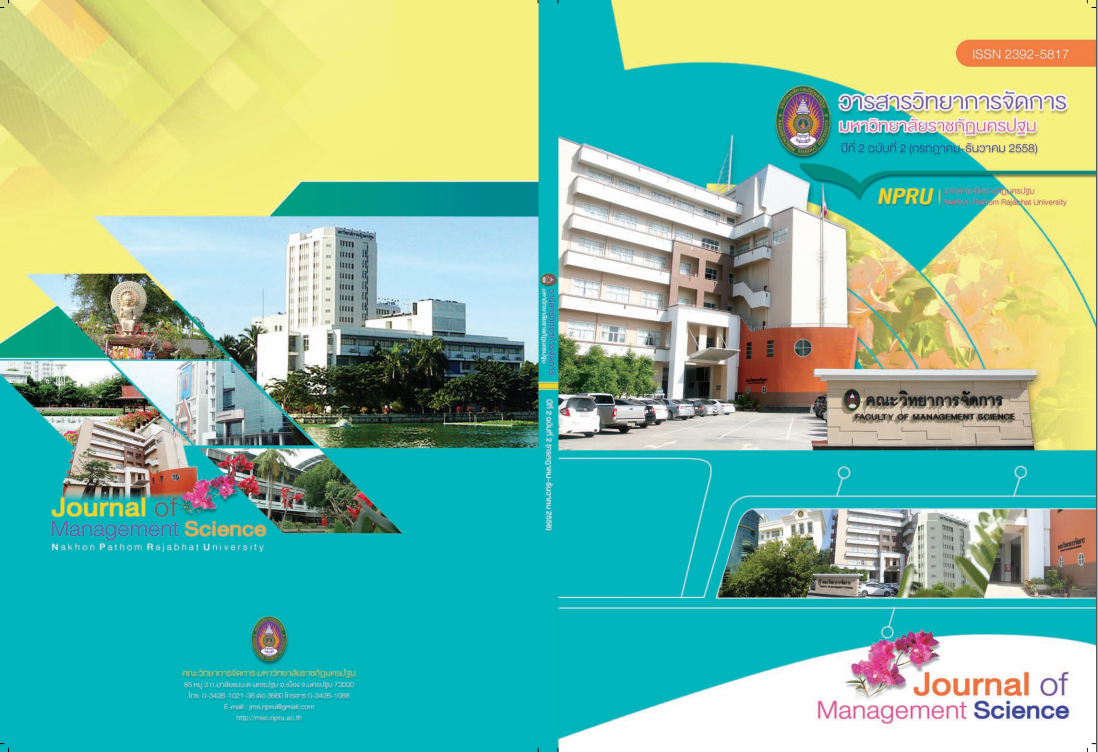Development to Marketing innovation to create competitive advantage in textiles and apparel in Thailand
Main Article Content
Abstract
This study aimed to 1) study the influence of marketing innovationtoward the increasing of value to increase competitive advantage on textile andgarment businesses 2) analyze the matching of marketing innovation structure with the of increasing value to increase competitive advantage on textile and garment businesses 3) specify the marketing innovation structure and the increasing value which influenced the increasing of competitive advantage on textile and garment business.
The finding results were as the following:
1. The marketing innovation and increasing value showed causal relationship with statistically significant different at 0.05 (p<0.05). The positive relationship with path coefficient was at 0.810. Regarding the efficiency of forecasting. It was found that causal relationship model related to marketing innovation and increasing value, which influenced the increasing competitive advantage on textile and garment businesses.
2. Marketing innovation had causal relationship with increasing competitive advantages. With statistically significant different at 0.05 (p<0.05) each of which had positive relationship with path coefficient at .927. In addition, the increasing value had causal relationship with the increasing competitive advantages with had path coefficient at 0.924 The efficiency of forecasting, found that causal relationship model related to marketing innovation and increasing value, which influenced to increasing of competitive advantage.
Article history : Accepted 27 October 2015
SIMILARITY INDEX = 2.08
Article Details
The views and opinions of the article appearing in this journal are those of the author. It is not considered a view and responsibility of the editorial staff.
References
กัลยา วานิชย์บัญชา. (2556). การวิเคราะห์สมการโครงสร้าง (SEM) ด้วย AMOS. กรุงเทพฯ : ห้างหุ้นส่วน จำกัดสามลดา.
จรินทร์ อาสาทรงธรรม. “การสร้างความได้เปรียบในการแข่งขัน (Competitive Advantage) ในมิติด้านนวัตกรรม (Innovation),” วารสารนักบริหาร. 25(2) : 15 เมษายน – มิถุนายน, ; 2548.
สัญญา สัญญาวิวัฒน์. (2546). สังคมวิทยาองค์การ.: กรุงเทพฯ : สำนักพิมพ์แห่งจุฬาลงกรณ์มหาวิทยาลัย.
สำนักงานเศรษฐกิจอุตสาหกรรมกระทรวงอุตสาหกรรม. (2554). แผนแม่บทการพัฒนาอุตสาหกรรมไทย พ.ศ. 2555-2574 National Industrial Development Master Plan. กรุงเทพฯ : กระทรวงอุตสาหกรรม.
สำนักงานคณะกรรมการการศึกษาขั้นพื้นฐาน. (2548). การประเมินนวัตกรรมด้านการเรียนการสอน. ค้นเมื่อ 16 กุมภาพันธ์ 2557. จาก https://www.obec.go.th/
Arbuckle J. L. (2011). AMOS 20.0 user's guide. Crawfordville.
Atuahene-Gima, K. (1996). Market Orientation and Innovation. Journal of Business Research, 35 (2), 93-103.
Comfrey, A. L., & Lee, H. B. (1992). A First Course in Factor Analysis. Hillsdale, NJ: Lawrence Erlbaum Associates.
Damanpour, F. 1991. Organizational Innovation: A meta-analysis of effects of determinants and moderators. Academy of Management Journal, 34(3): 555-590.
Farrell, M.A. & Oczkowski, E. (2002). Are market orientation and learning orientation necessary for superior organizational performance?. Journal of Market Focused Management, 5, 197-217.
Glazer, Rshi. (1991). Marketing in an information-intensive environment : strategic implications of, knowledge as an asset, Journal of Marketing, (October), 1-19.
Higgins, E. T., & Brendl, C. M. (1995). Accessibility and applicability: Some "activation rules" influencing judgment. Journal of Experimental Social Psychology, 31, 218-243.
Magrath, A.J. and J.M. Higgins. “Six Pathways to Marketing Innovation; The Value AddedAnalysis : A Seventh Pathways to Marketing Innovation,” Planning Review. 20(6) : 12 – 19 ; 1992
Saris, W. E. & Strenkhorst, L. H. (1984). “Causal modeling non experimental research : An Introduction to the Lisrel approach” Dissertation Abstract International, 47(7), 282.
Siggelkow, N. (2002). Evolution toward fit. Administrative Science Quarterly, 47(1), 125-159.
Thompson, V.A. (1965). Bureaucracy and innovation. Administrative Science Quarterly, 10 (1), 1-20.


